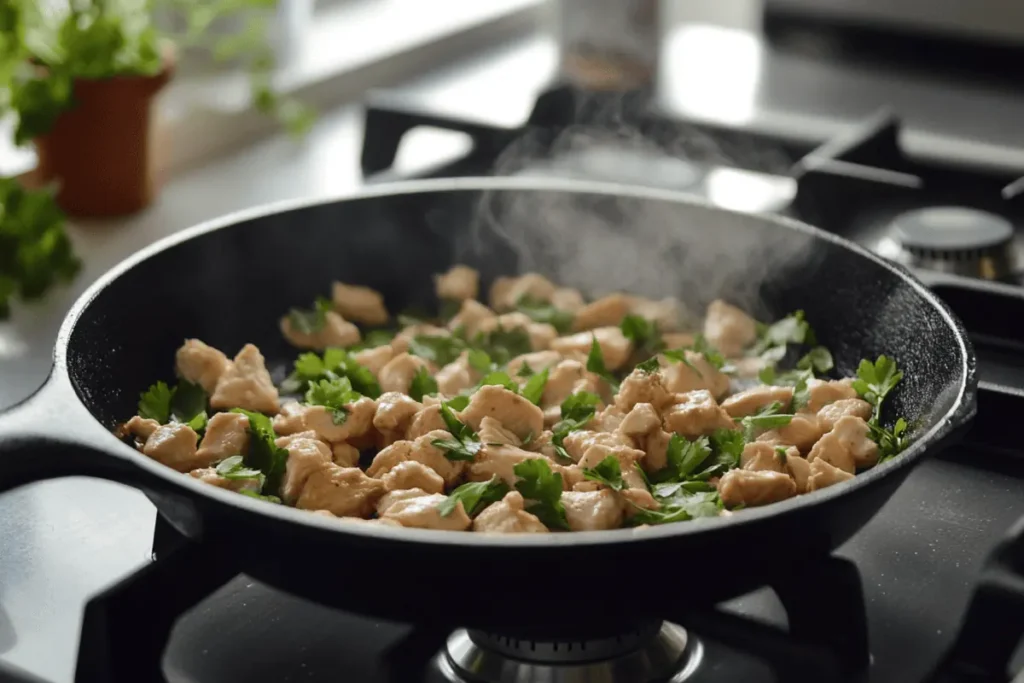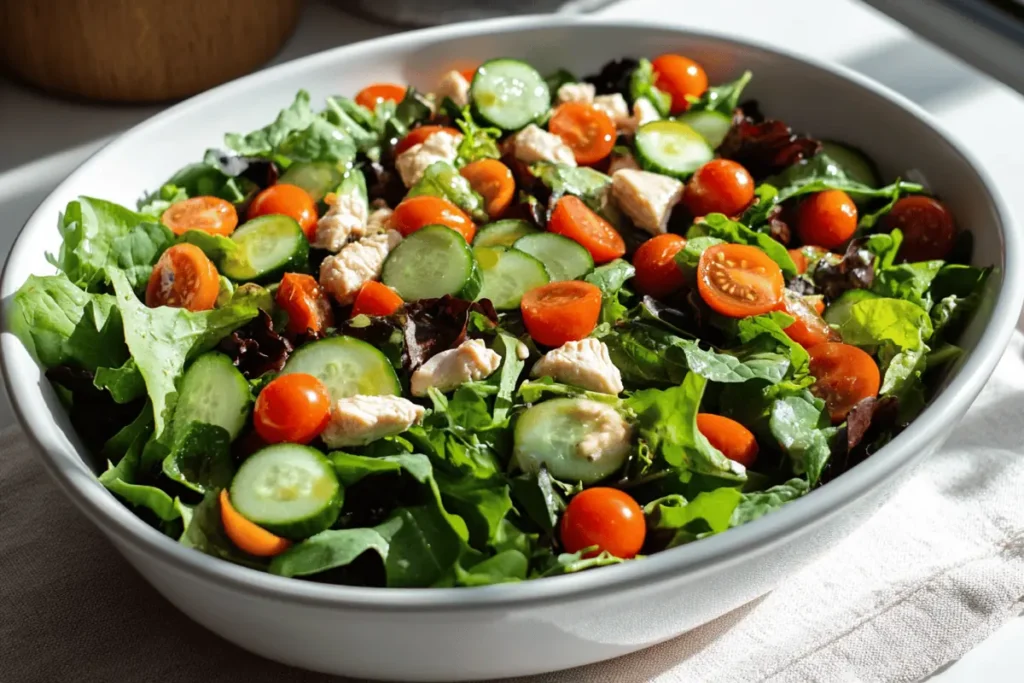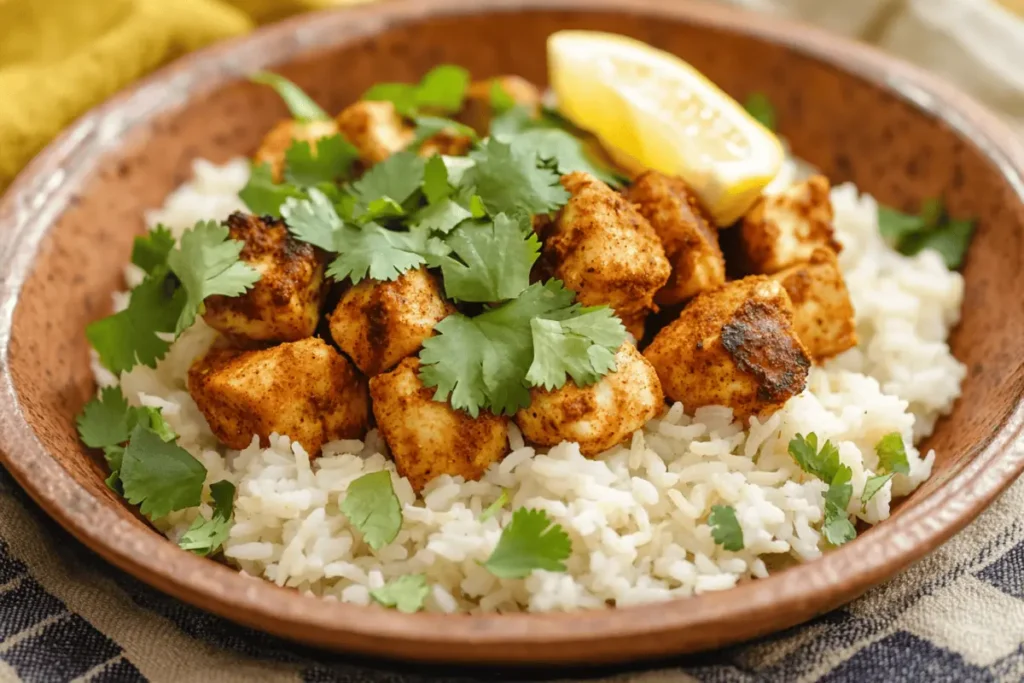When you want a simple yet versatile protein option, cubed chicken often comes to mind. These bite-sized pieces fit into countless recipes and cooking methods. Moreover, they cook quickly and absorb flavors with ease. Whether you want a quick stir-fry or a hearty casserole, cubed chicken helps you get dinner on the table fast. In fact, diced chicken recipes appear in many cuisines, from Asian-inspired dishes to Italian classics. By learning a few basic techniques, you can master cubed chicken and open the door to endless culinary possibilities. More importantly, working with chopped chicken makes mealtime more flexible, allowing you to adjust flavors, textures, and portion sizes without stress.
Table of contents
Why Cubed Chicken Enhances Your Cooking Experience
Choosing cubed chicken changes the way you approach cooking. First, smaller pieces increase the surface area exposed to marinades and seasonings, so every bite bursts with flavor. Also, cubed chicken often cooks faster than whole breasts or thighs. This quick cooking time proves helpful on busy weeknights when you need dinner ready in minutes. Additionally, diced chicken or chopped chicken blends seamlessly into many dishes. Think about soups, salads, curries, and pasta sauces. By using cubed chicken breast recipes, you break down complex tasks into manageable steps. You gain confidence in the kitchen and feel more adventurous with your menu. Thus, cubed chicken recipes not only diversify your meal plan but also improve your cooking skills.
Choosing the Right Cut for Cubed Chicken
When deciding which cut to cube, chicken breasts remain the most popular choice. They are lean, mild in flavor, and easy to work with. Diced chicken breast recipes benefit from this cut’s uniform texture and low fat content. Yet, chicken thighs also hold their own appeal. They have a slightly richer taste and can stay moist after cooking. You can also try mixing both breast and thigh meat for a balance of flavor and tenderness. Regardless of your preference, ensure you use fresh, high-quality chicken. Trim any excess fat, remove cartilage, and pat the meat dry before cutting. With care and attention, you create consistent pieces ready for cooking in no time.
Proper Techniques for Cutting Chicken into Cubes
Before you start slicing, grab a sharp knife and a sturdy cutting board. Place the chicken breast flat on the board, then slice it lengthwise into strips about one inch wide. Next, rotate these strips and cut them crosswise into even cubes. Aim for uniformity so each piece cooks at the same rate. If you are working with thighs, remove the bone (if present) and trim the skin. Repeat the same technique: cut into strips and then into cubes. Over time, you develop speed and precision. Soon, you will cube chicken without hesitation, turning any recipe into a diced chicken masterpiece.
Cooking Methods for Cubed Chicken
Cooking cubed chicken does not follow one single rule. Instead, you can choose from several methods depending on your time, tastes, and preferred recipe. For instance, sautéing works great for quick meals. Simply heat oil in a skillet, add chopped chicken, and season with salt, pepper, and your choice of herbs or spices. In minutes, you have tender, juicy chicken chunks ready for salads or stir-fries. Another option involves roasting in the oven. Toss cubed chicken with a bit of oil and seasonings, then spread it on a baking sheet. Within about 15-20 minutes at 375°F (190°C), the chicken turns lightly golden and fully cooked. Yet another method includes simmering chicken in a flavorful sauce or broth. This technique infuses diced chicken with rich, deep tastes, making it ideal for curries, stews, or casseroles.

How Long Do You Cook Chopped Up Chicken Breast Tonight?
The cooking time depends on the method. If you sauté diced chicken breast in a pan, it may take about 5-7 minutes, depending on the cube size. Always check that the internal temperature reaches 165°F (74°C) for safety. When roasting cubed chicken at 375°F, 15-20 minutes usually suffice. If you simmer chicken chunks in a sauce, it can vary. For soups or stews, around 10-15 minutes of gentle simmering might be enough, as long as the pieces are small and uniform. Always rely on a reliable kitchen thermometer to ensure thorough cooking. By understanding these guidelines, you can cook chopped chicken to perfection every time.
Flavor Boosters for Cubed Chicken Recipes
Because cubed chicken adapts to different cuisines, feel free to experiment with marinades, spice rubs, and sauces. For a simple marinade, whisk together olive oil, lemon juice, minced garlic, and dried herbs like oregano. Let the cubed chicken rest in this mixture for at least 30 minutes before cooking. If you prefer bolder flavors, try a yogurt-based marinade with cumin, paprika, and a pinch of chili flakes. Meanwhile, an Asian-inspired glaze might include soy sauce, ginger, and a drizzle of sesame oil. After marinating or seasoning, cook the chicken using your chosen method. The result? Cubed chicken that is tender, juicy, and positively brimming with taste.
Herbs, Spices, and Aromatics for Diced Chicken
You can transform basic cubed chicken recipes into restaurant-quality dishes by adding the right aromatics. Onion, garlic, and shallots bring sweetness and depth. Ginger adds brightness, while lemongrass offers a citrusy kick. For spices, consider cumin, coriander, or curry powder. Dried herbs like thyme, rosemary, and basil complement many recipes. Even a squeeze of fresh citrus juice or a splash of vinegar at the end can enliven flavors. Also, remember that seasoning your diced chicken lightly at the start and adjusting just before serving helps maintain balance. By blending these elements, you create a chicken chunks recipe that wows your guests without complicating the cooking process.
Diced Chicken Recipes from Around the World
Cubed chicken appears in many global cuisines. In Italian cooking, chopped chicken can star in pasta dishes. Sauté diced chicken with garlic and olive oil, then toss it with penne, cherry tomatoes, and a handful of fresh basil. For a Mexican flair, season cubed chicken with chili powder, cumin, and paprika before filling tortillas with the mixture. Add some pico de gallo and guacamole, and you have tacos that delight your taste buds. Asian cuisines often use diced chicken in stir-fries. Combine it with colorful veggies, soy sauce, and ginger for a quick dinner. Finally, think about Middle Eastern flavors: marinate chicken in yogurt, lemon, and spices, then grill the cubes for a juicy, tender finish.
Cubed Chicken in Salads, Wraps, and More
Diced chicken fits seamlessly into fresh salads, perfect for a light lunch or dinner. Toss chopped chicken with leafy greens, cherry tomatoes, sliced cucumbers, and a vinaigrette for a crisp, healthy meal. Wraps also benefit from chicken chunks. Spread hummus or a light sauce on a tortilla, layer with chicken and crunchy vegetables, and roll it up. You get a portable, protein-packed meal in minutes. Furthermore, diced chicken breast recipes often appear in casseroles or one-pot meals. Stir it into cooked rice, add some broth, vegetables, and cheese, then bake until bubbly. This comfort food approach ensures everyone leaves the table satisfied.

Chopped Chicken Recipes for Busy Weeknights
With hectic schedules, you need meals that come together quickly. Cubed chicken shines in these scenarios. Consider a simple skillet dish: sauté diced chicken, add a handful of spinach and cherry tomatoes, sprinkle with feta cheese, and serve with whole-grain bread. Done in under 20 minutes, this chopped chicken recipe proves that healthy eating does not require elaborate steps. Another quick fix involves stir-frying chicken chunks with frozen vegetables and a bottled sauce. Serve over brown rice, and you have a balanced dinner with minimal prep. Even a basic sandwich benefits from cubed chicken tossed in a tangy dressing. With these time-saving tricks, you no longer need to compromise flavor or nutrition when short on time.
Incorporating Leftovers for Less Waste
If you have leftover cubed chicken from a previous meal, repurpose it to avoid waste. Add it to a soup or a hearty grain bowl. Mix it with scrambled eggs for a protein-rich breakfast. Top a homemade pizza with diced chicken and fresh veggies. The options remain endless. By seeing chopped chicken as a building block, you turn potential leftovers into new delights. This approach saves money, reduces kitchen waste, and ensures you always have something tasty on hand.
Cooking Tips for Perfect Cubed Chicken Results
Successful cooking starts with quality ingredients and proper preparation. Always pat chicken dry before cutting to avoid slippage. Use a sharp knife to maintain control and consistency in cube size. To lock in juices, let marinated chicken come to room temperature before cooking. This allows for even heat distribution and reduces the risk of overcooking. If you plan to add chicken chunks to a hot sauce, cook them separately first to ensure they do not become rubbery. Stir them in at the end of cooking for best results. By following these tips, you will master cubed chicken and produce tender, juicy results every time.
Avoiding Common Mistakes with Diced Chicken
A few pitfalls can occur when cooking diced chicken. One mistake is overcrowding the pan. If you add too many pieces at once, they steam rather than brown. Instead, cook in batches if necessary. Another issue arises when cutting cubes too large or too small. Large cubes take longer to cook, risking dryness on the outside by the time the inside is done. Tiny pieces can overcook easily. Aim for uniform, medium-sized cubes, about an inch wide. Finally, remember not to rely solely on time. Use a thermometer to ensure the center reaches 165°F. With attention and care, you sidestep these errors and perfect your chicken chunks recipe.
Balancing Nutrition and Flavor with Cubed Chicken
Cubed chicken supports a balanced diet. Lean chicken breast provides quality protein with minimal saturated fat. Pair it with vegetables, whole grains, and healthy fats for a complete meal. Because diced chicken absorbs flavors easily, you can reduce high-fat sauces or excessive salt by relying on herbs, spices, and a squeeze of citrus. Serving cubed chicken alongside a salad, roasted vegetables, or a whole grain like quinoa or brown rice ensures a nutrient-rich plate. This flexibility encourages you to incorporate more wholesome ingredients, making your meals both tasty and nourishing.

Lowering Sodium and Adding Fresh Ingredients
If you watch your sodium intake, skip heavily processed marinades or sauces. Instead, enhance flavor with fresh ingredients. Lemon zest, fresh herbs, and a bit of extra-virgin olive oil can do wonders. When making a sauce from scratch, taste as you go and add salt sparingly. Vinegars, mustards, and spices contribute complexity without boosting sodium. Even topping your finished dish with fresh chopped parsley or cilantro increases flavor and visual appeal. By focusing on freshness, you create cubed chicken recipes that promote health without sacrificing taste.
Conclusion
Cubed chicken simplifies dinner, streamlines meal prep, and enhances flavor absorption. By learning how to properly cut, season, and cook chopped chicken, you unlock endless culinary potential. With practice, you transform diced chicken breast recipes into cherished family favorites or exciting new global dishes. Moreover, the adaptability of diced chicken makes it suitable for healthy, quick meals and comforting weekend feasts alike. Experiment with herbs, spices, and cooking methods to discover your signature chicken chunks recipe. Over time, cubed chicken becomes a reliable kitchen ally, ensuring you always have a versatile, protein-packed solution ready for tonight’s dinner and beyond.
Frequently Asked Questions
What is cubed chicken?
Cubed chicken refers to chicken meat cut into small, uniform pieces. Typically, you cut boneless, skinless chicken breasts or thighs into cubes about 1-inch in size. These pieces cook quickly and evenly, making them perfect for many diced chicken recipes.
How do you properly cube a chicken?
To properly cube chicken, start with a sharp knife and a stable cutting board. Cut the chicken breast into even strips and then crosswise into cubes. Aim for uniform pieces so they cook at the same rate. Keep your knife blade sharp for clean cuts and better control.
How long does it take for diced chicken to cook?
Cooking times vary by method and piece size. When sautéing chopped chicken, it often takes about 5-7 minutes over medium-high heat. Always ensure the internal temperature reaches 165°F (74°C) for safety. Baking or roasting may require 15-20 minutes at 375°F (190°C). Check doneness with a thermometer.
Is it better to bake chicken at 350 or 400?
Both temperatures work, but 375°F (190°C) often provides a balance of browning and tenderness. At 350°F, the chicken may take longer and can become drier. At 400°F, it may brown faster but require close monitoring. Consider starting at 375°F for best results, adjusting time as needed.

